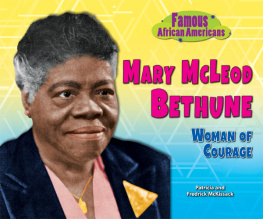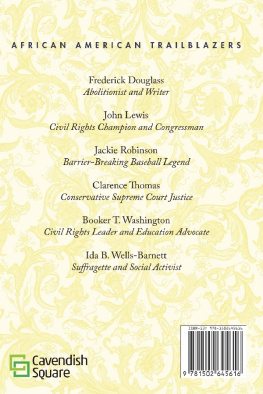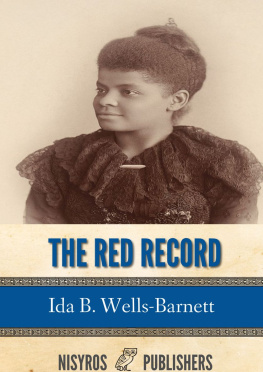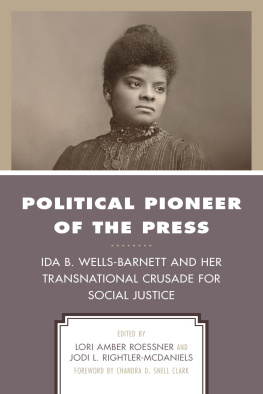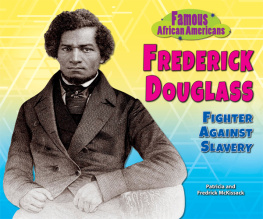A VOICE AGAINST VIOLENCE
IDA B. WELLS-BARNETT BEGAN WRITING ARTICLES ABOUT UNFAIR LAWS, AND HOW AFRICAN AMERICANS WERE BEING HURT. SHE WROTE NEWSPAPER ARTICLES TO BRING THE VIOLENCE TO PEOPLES ATTENTION. READ ABOUT IDAS LIFE IN THE FAMOUS AFRICAN AMERICANS SERIES.
ABOUT THE AUTHORS

Patricia and Fredrick McKissack have written over one hundred books about the African-American experience. They have won countless awardsincluding the Coretta Scott King Awardand received much critical acclaim, all the while bringing enjoyment and information to young readers.

Image Credit: Department of Special Collections, University of Chicago Library
Ida B. Wells loved to write when she was young. When she grew up, she wrote about equal rights and unfair laws.
The Civil War ended in 1865, and so did slavery in America. Jim and Lizzie Wells were freed. So was their threeyearold daughter, Ida. The family lived in Holly Springs, Mississippi. Seven more children were born.
Ida was sent to school. Learning was easy for her. She liked to read, but writing was more fun. She made her parents proud. Besides being smart, Ida Wells grew into a pretty girl with honeybrown skin. She was also loving and kind.
Then came the fever! Yellow fever was a killer disease. There was no cure at that time. Many good people died in Holly Springs. Jim and Lizzie were among them. So was their baby son.
Ida was just sixteen years old. Their Holly Springs neighbors wanted to take the children to live with them. But Ida kept her family together. They lived in the house her parents left for them. She got a job as a country school teacher to earn money.
The next year, Ida let other family members take the children. Ida moved to Memphis, Tennessee, and got another job teaching there.

Image Credit: Ned O.
Ida got a job teaching children to earn money for her family.

Image Credit: Ned O.
Ida was told to change seats on the train because she was black.
After the Civil War, laws were passed that protected the rights of all Americans regardless of color. Blacks had the same rights as whites. They rode in train cars together, sat together in public places, and shared the same public drinking fountains. But by 1878, laws began to change.
Ida taught in a oneroom schoolhouse near Memphis. She rode the train into town at the end of each week.
One day Ida bought a train ticket to Memphis. She sat in the front car. The conductor told Ida to move to the car where men who smoked rode. It was called a smoker car.
Why? She was black. For many years, it was against the law to make people sit in separate cars because of their color. Ida did not know that this law had changed. She would not move. The conductor took her arm. She bit him. He called for help. Another man came. They picked Ida up and made her move. No one helped her. Ida would not sit in the smoker car. Instead she got off the train.

Image Credit: Ned O.
Ida fought against the men who tried to make her change seats on the train.
Ida was very angry. She was just twenty-one years old, but she decided to fight for her rights another way. She took the railroad company to court. She found a lawyer to take her case. Months passed. Nothing happened. Ida learned that her lawyer had been paid off by the railroad. She found another lawyer.
Finally, the case went to court. Ida won her case. The judge ordered the railroad company to pay Ida $500. It was her first fight for freedom!
The railroad took the case to another court, and this time, Ida lost.
From 1880 to 1900, states passed more laws that took away black peoples rights. Ida would always speak out against unfair laws.
Ida Wells went to Rust College in Holly Springs, and Fisk University in Nashville, Tennessee.
She still taught school in Memphis. Often Ida spoke out about how poor black schools were. She wrote for a church newspaper, The Living Way. She spoke up about rights and fair laws. Soon she was asked to write for other black newspapers, too.
In 1889, Ida became part owner of a Memphis newspaper, Free Speech. Once she wrote about black schools in Memphis. She said they were run-down and crowded, and there were not enough books. Ida lost her teaching job after that. But she did not stop speaking out.

Image Credit: Ned O.
Ida wrote articles for newspapers about rights and fair laws for all people.

Image Credit: Ned O.
Laws were passed that made it hard for black people to vote.
In many southern states, laws were being passed that took away the rights of African Americans. Some laws made it very hard for blacks to vote. When blacks tried to vote they were beaten. Their houses and businesses were burned. Many times they were hanged. Murdering people this way was called lynching.
Ida wrote about these terrible beatings, house burnings, and lynchings. She spoke out against the unfair laws that were being passed. Friends told her to be careful. Maybe she should stop. No! She would keep writing the stories.
Then, in 1892, three young black men were shot to death. They had done nothing wrong. Ida wanted people to protest this tragedy. Say or do something, Ida wrote. Very few people said or did anything.
Finally, a group of angry men burned the office of Free Speech. Ida got away just in time.
Running wasnt easy for Ida. She wanted to stay in Memphis and fight against violence. Her friends said, go North. Go where it will be safe to speak out!
And so she did. Ida B. Wells went to New York. Her work was not over. It was really just beginning.
Ida worked for the New York Age newspaper in New York. T. Thomas Fortune was the owner. He said Ida had plenty of nerve. Those who knew Ida agreed with Mr. Fortunes words.
In 1893, Ida decided to move to Chicago. There she began writing for an African-American newspaper owned by Ferdinand L. Barnett. Ida went all over the United States and Europe asking people to join her in her fight. Thousands and thousands of people joined her.
In 1895, Ida wrote a small book named




